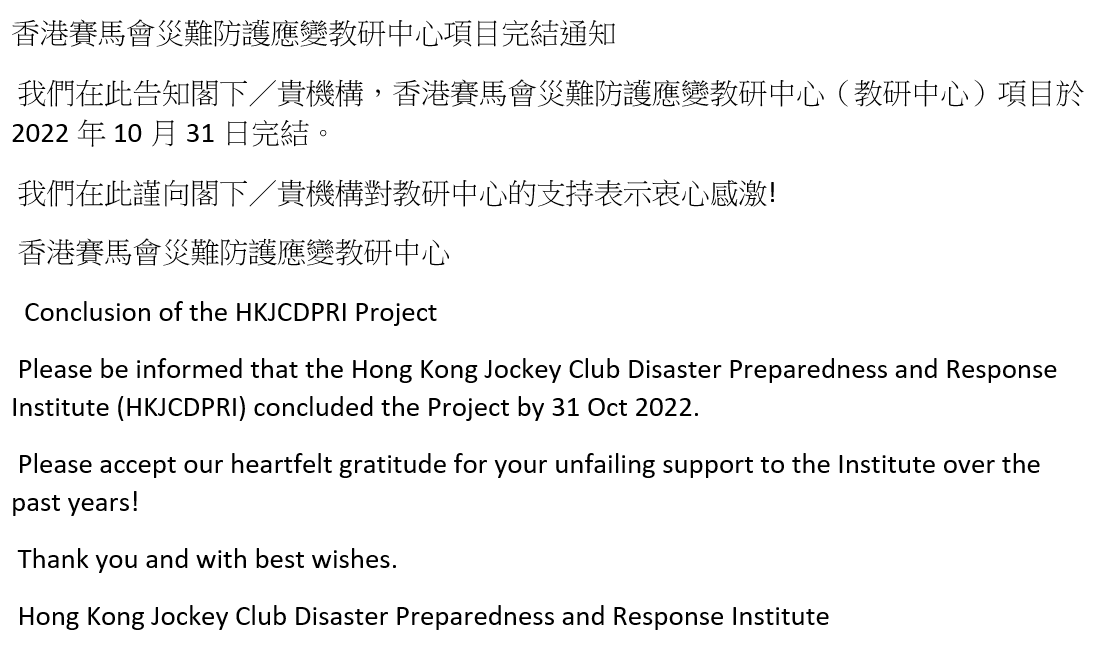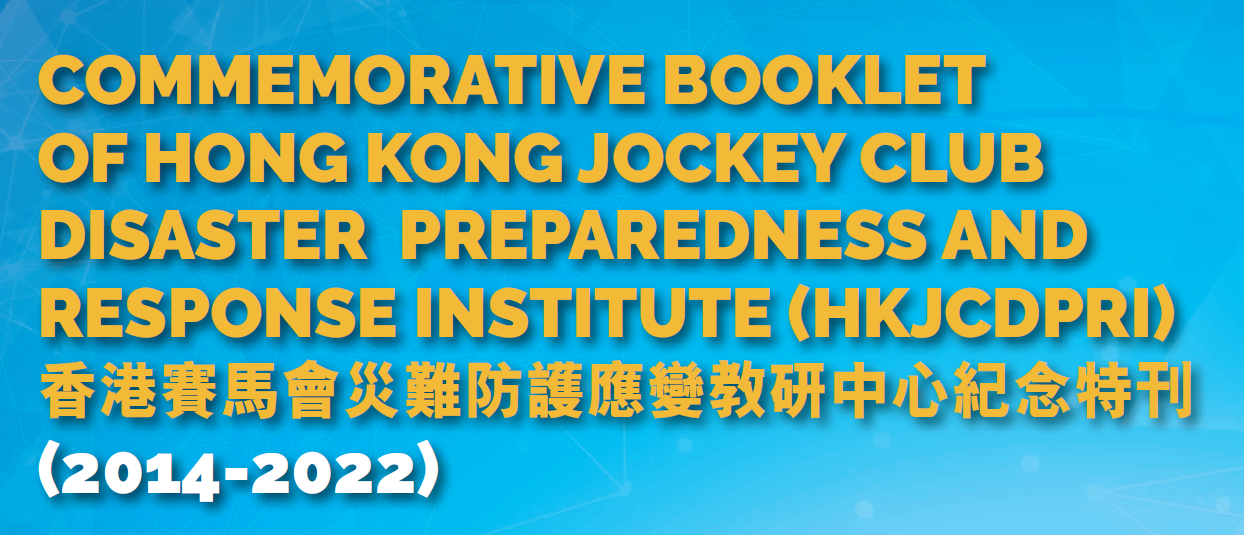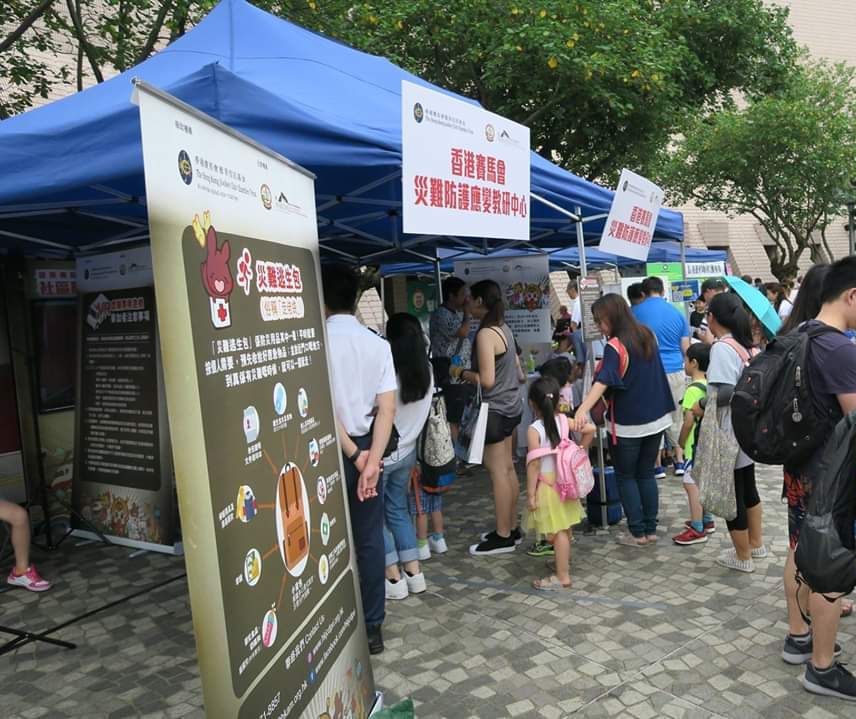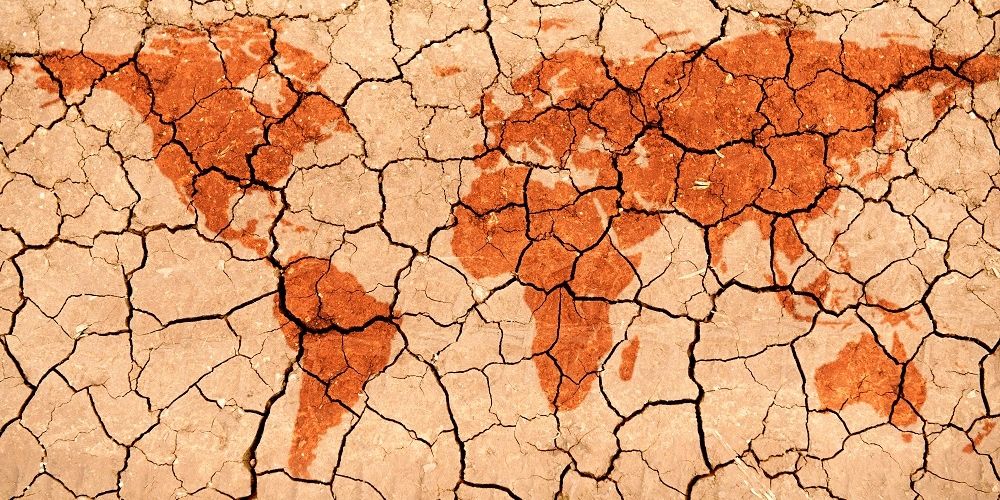You are here
E-learning Platform
E-learning Platform

2022
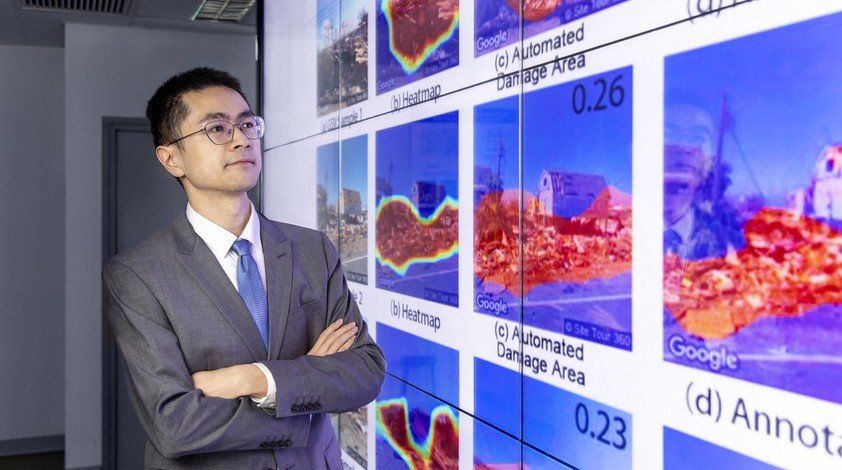

[This article is only available in Chinese.]
[This article is only available in Chinese.]
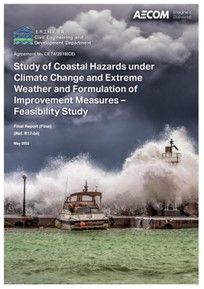

Pages
E-learning Platform
2022

*This article originates from Hong Kong Baptist University
4 January 2022
Peaking with one-minute sustained winds of 285 km/h, the Category 5 Hurricane Irma ripped through the Caribbean islands and the southeast of the United States in September 2017. After the storm made landfall in Florida, it caused widespread destruction along its path, tearing off roofs, flooding coastal cities, and causing at least 84 fatalities in the state.
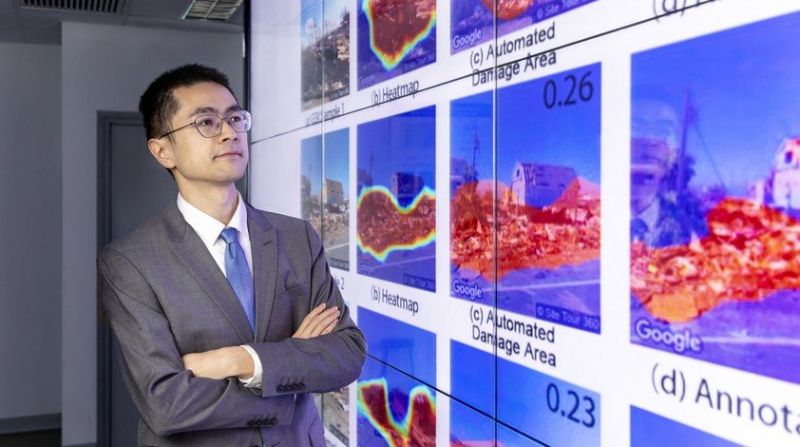
Dr Zhai has been researching the use of artificial intelligence to improve our understanding of individuals' perception of disasters and the damage they cause. The research team found that damage assessments based on Google Street View images can provide timely and accurate data on the ground. Such information is invaluable to humanitarian organisations and disaster management practitioners, as it allows them to devise recovery strategies.
The impact of the deadly storm and the local government's response to the disaster made a lasting impression on Dr. Zhai Wai
, who was then pursuing his postgraduate studies at the University of Florida, and he had just arrived in the state a few days before the hurricane hit.
Four years later, he is investigating how to improve disaster management. "Seeing firsthand how disasters such as hurricanes and flooding affect the people living in coastal regions, I believe that urban planners play an important role in helping governments develop strategies to respond to the disasters and improve social equity in the face of extreme weather events," says the Assistant Professor of the Department of Geography.
A human-centric approach
Assessing how people perceive risk and damage in the context of natural hazards is central to improving disaster preparedness and recovery. To that end, Dr Zhai has been researching the use of artificial intelligence (AI) to improve our understanding of individuals’ perception of disasters and the damage they cause.
In a study examining the use of Google Street View (GSV) images in damage assessment, Dr Zhai and his colleagues looked at how the human eye perceives the amount of damage present in GSV images. "Existing approaches, such as remote sensing imagery, typically use satellite imagery and measure the damage in an area at a distance, but this cannot reflect how people are actually interpreting the disaster situation. Our research took a more human-centric approach, and it reflects how individuals perceive disasters," says Dr Zhai.
The team applied a deep learning model to automate the process of evaluating post-disaster damage levels using GSV images, and they found that GSV-based damage assessments offer insights that remote sensing imagery cannot, such as recording damage to exterior walls, windows and doors. When the overall damage level is relatively low, a GSV-based damage assessment can provide timely and accurate data on the ground. Such information is invaluable to humanitarian organisations and disaster management practitioners, as it allows them to devise recovery strategies.
Assessing situational awareness through social media
According to Dr Zhai, another critical aspect of disaster management involves addressing the recovery needs of different neighbourhoods. In particular, a neighbourhood's situational awareness (SA), or their understanding of the situation in the field, helps disaster response agencies stabilise the risks and prevent further losses in disadvantaged communities, thereby improving equity in terms of disaster assistance and relief.
Although SA is hard to obtain during a disaster due to logistical and communication difficulties, Dr Zhai believes that many of these challenges can be solved with new technologies. "With the use of AI technology, we can analyse geotagged data on social media and learn how the users of the affected areas are responding to the disaster in real-time," he says. "When compared to the current approaches of conducting surveys and retrospective studies, the application of AI enables us to find out the attitudes and concerns of a much larger population."
In his research project
, Dr Zhai and his colleagues adopted machine learning-based natural language processing methods to conduct sentiment analysis on social media posts. He says, "This type of user-generated content can also be combined with the users' sociodemographic information, which could help us assess which neighbourhoods are more vulnerable in a disaster event. By understanding disaster SA from the perspective of social equity, the authorities can make faster and more accurate decisions on response efforts."
Building a disaster-resilient city
Having grown up in a small town in mainland China, Dr Zhai has always been fascinated by the development and functions of megacities, as well as how social equity can be improved through urban planning. After obtaining a master's degree in urban planning from Tsinghua University, he pursued both a master's degree in computer engineering and a PhD in urban and regional planning at the University of Florida.
"When I was carrying out research in urban planning, I found that there were some computer engineering techniques I needed to apply to my project, so I became determined to learn programming skills and new technologies in order to complete my research," he says. As he did not have any background in computer science at the time, it was his sheer determination and passion for research, as well as help from computer-savvy friends, that carried him through. "Learning computer engineering techniques was quite an interesting and fruitful experience in my career. It has been beneficial to my current research projects."
Having joined HKBU this year, Dr Zhai is particularly interested in working with researchers from both of the branches in geography: human geography and physical geography, as his research interests cover the study of urban planning as well as extreme weather events. He is also working on an interdisciplinary research collaboration with Dr Celine Song of the Department of Journalism, and their study focuses on disaster misinformation and corrections on social media.
While he believes that Hong Kong is well-prepared for typhoons and that it has effective emergency response plans in place, he says that the coastal city will be susceptible to the threat of rising sea levels in the future. He has been developing a research project on how rising sea levels influence property prices, which can provide insights into the impact of climate change on urban development. He says of his motivation for research, "I find research work very rewarding, as it can make a real contribution by helping decision-makers and disaster management practitioners develop improved response strategies and capabilities."

[This article is only available in Chinese.]
[This article is only available in Chinese.]
原文轉載自香港桂冠論壇 https://hklaureateforum.org/zh-tw/post-pandemic-economic-recovery
全球新冠疫情與氣候變化,同樣顯露了人類社會全球性、系統性而複雜的危機,都需要我們進行相關科學研究,並同時採取行動減緩和適應其對社會各環節的干擾,以及對脆弱群體造成的嚴重影響。新冠疫情造成全球危機之際,溫室氣體排放一度下跌正好給我們啟示和契機,就是只有以綠色復甦的措施修復這個複雜的體系,才有機會提高我們對疫症和氣候變化兩者的韌性[1]。
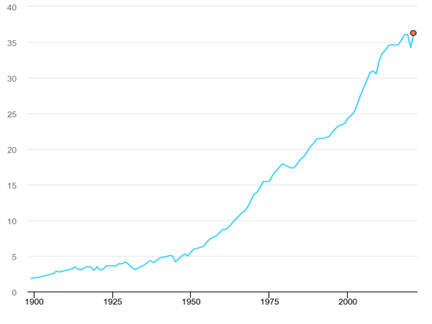
圖1:全球溫室氣體排放量
來源︰國際能源機構(IEA)
2020年初開始,新冠疫情在全球各地爆發,尤其是對人口稠密的地區造成重大的公共衛生風險,也一度擾亂了全球生產和物流系統,並降低了空氣污染和溫室氣體排放水平。有科研人員監測了自2020年以來發表的數以百計經過同行評審的文獻[2],都是試圖在新冠疫情下將空氣污染或碳排放水平與人體健康、生態環境的關係聯繫起來。然而,他們認為,要判斷新冠疫情是否減緩空氣污染和氣候變化的影響並非易事,這不僅涉及病毒的傳染力和毒性、大氣和氣候系統本身,還涉及排放技術、氣象條件,經濟趨勢變化、社會體制及治理水平的因素。
新冠疫情下科學研究仍需長期觀察 未有定論
固然,在新冠疫情下,空氣污染排放受到運輸物流減少、社交距離限制以及政府強制封城的影響,直接使2020年的全球碳排放比2019年下跌了5.2%。部份學者整合了電力市場、健康和運輸物流的數據,指出了美國電力消耗的減少與新冠肺炎案例、社交距離和商業活動水平之間的密切相關 。不過,即使如此,到目前為止,相關科學研究只是處理了環境、人類和技術方面的問題,對於較難量化的體制和政策卻沒有那麼關注,例如實施封城的影響。就像不少研究新冠肺炎和空氣污染對健康的影響一樣,不少文獻將天氣和氣候因素與新冠肺炎傳播聯繫起來,卻沒有考慮相關的非環境因素,包括政策、社會體制和技術創新等。
此外,相關科學研究需要考慮到隨時間而變化的短期和長期因素。自從新冠疫情爆發以來,隨著感染率的變化和政策的調整,每週的趨勢都在變化;新冠疫情還同時改變了體制和政策應對措施,包括與氣候變化有關的減緩、適應和反饋措施,反過來影響碳排放和氣候。許多人把重點放在量化短期影響上。量化社會回應的數據還很少,而且大多數分析都是前瞻性的。因此,隨著新冠疫情及其影響將會持續,長期數據收集和分析的潛力很大。
隨著全球各地封鎖和社交距離措施的解除,碳排放已再次增加。到2021年,全球碳排放已回升至疫情前的排放水平 。顯然,2020年碳排放減少還不足以對全球氣候產生長遠的影響。即使仍在疫情期間,氣候變化的影響從沒有間斷,全球依然發生山火和洪水等災害,而病毒流行也存在氣候、溫度和人類行為的影響。筆者認為,科學研究的角色已經超過技術的創新,而是要研究增進了疫情下氣候變化和碳排放兩個系統的相互作用,但不能等到有概括性結論便要採取有效的政策行動回應。
新冠疫情下氣候變化持續及加快減緩措施
換言之,全球氣候變化與新冠疫情的兩者之間相互影響尚須要更多研究,而從目前觀察所得,氣候變化還沒有因為新冠疫情而緩和。相反,全球各地每年將花費數以萬億元的經費推動各種疫情後的復甦措施。然而,到目前為止,每年只有約2%的公共支出是用於潔淨能源和氣候變化適應 ,其餘的可再生能源投資承諾仍未兌現。最常見的可再生能源包括太陽能、風能、地熱能及小型水力發電等,都是最直接取代化石燃料和減少碳排放的方法,因為它產生的能源不會引起碳排放。越來越多先進經濟體正在開始淘汰化石燃料,而轉用可再生能源。國際能源機構警告,目前觀察到的新冠疫情後的復甦是不可持續,世界必須加快能源轉型[6]。他們也預測2023年全球碳排放將會達到新的高峰。
那麼香港的經濟復甦是否綠色的?而香港的綠色復甦又應該包括什麼內容?公營機構、私營企業和社區如何一起推動綠色復甦?低碳想創坊的巴黎氣候監察計劃於2021年9月發表了題為《尋覓一線曙光—疫情後香港達成淨零排放的策略》的特別報告[7],為新冠疫情後香港的綠色復甦提出了一些重要的趨勢和政策建議。
香港作為國際組織C40城市氣候領導聯盟的其中一個始創成員,環境局局長黃錦星有份參與制定和提出以下C40城市首長綠色和公義復甦議程的六點呼籲[8],包括:
- 唯一的經濟復甦措施應該是綠色復甦;
- 致力於公平和包容的復甦;
- 維護及推動公共交通服務;
- 優先考慮和投資可再生能源;
- 投資增強城市的氣候韌性,作為復甦的引擎;
- 停止對化石燃料的所有公共投資。
上述的六點呼籲,如何用於分析香港三大排放源,即發電、建築和交通運輸,以及為香港的金融、創新科技和社區帶來的意義,本文將會根據上述特別報告的建議加以闡釋。
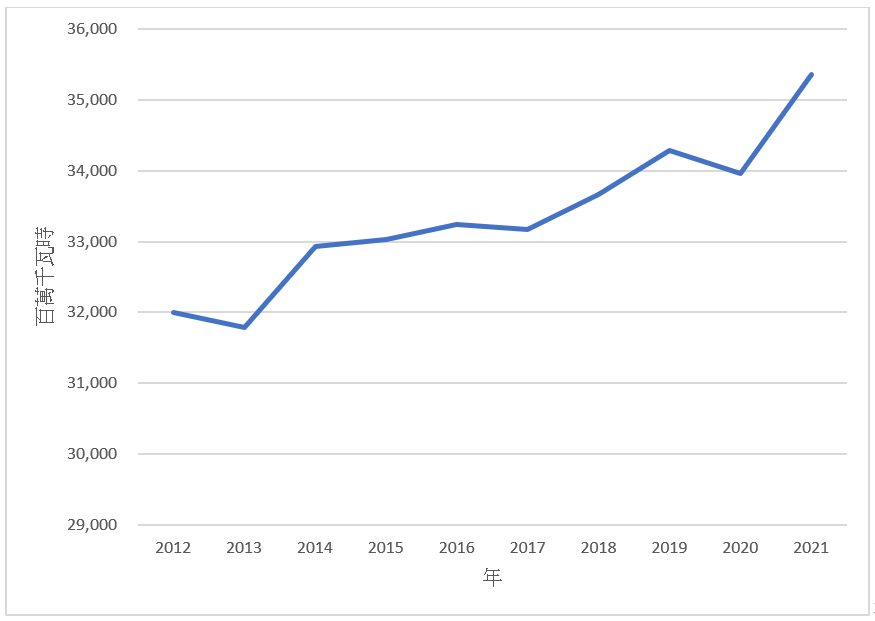
圖2:中電的香港售電量
來源:中電年報
能源發電行業須把握供應鏈改變推動綠色復甦
能源發電行業佔香港總碳排放約七成[9]。新冠疫情下,香港的用電量於2020年相比2019年只錄得1.6%的小幅度下降,而到了2021年,香港兩電的售電量便已大幅回升3.7%,比疫情前的2019年高2.0%。根據兩電最新公佈的售電數據,2021年的商業售電量幾乎恢復,只是比2019年疫情前水平低2.3%,而2021年住宅售電量更比2019年高出9.6%,比以往10年平均增幅的1.5%高出5倍有多[10]。單從這些數字,我們未能急於下結論新冠疫情沒有減少商業用電,反而在家工作大幅增加了住宅用電的說法,還需要進一步觀察。此外,特區政府多年來一直對工商業和住宅用戶提供的電費補貼,也可能不利於節省用電的努力。
即使如此,對於香港能源發電行業,上述趨勢意味著我們不能單靠鼓勵用戶節省用電來減少碳排放,而必須多管齊下,從轉用可再生能源和提高能源效益著手,推動長遠減碳。
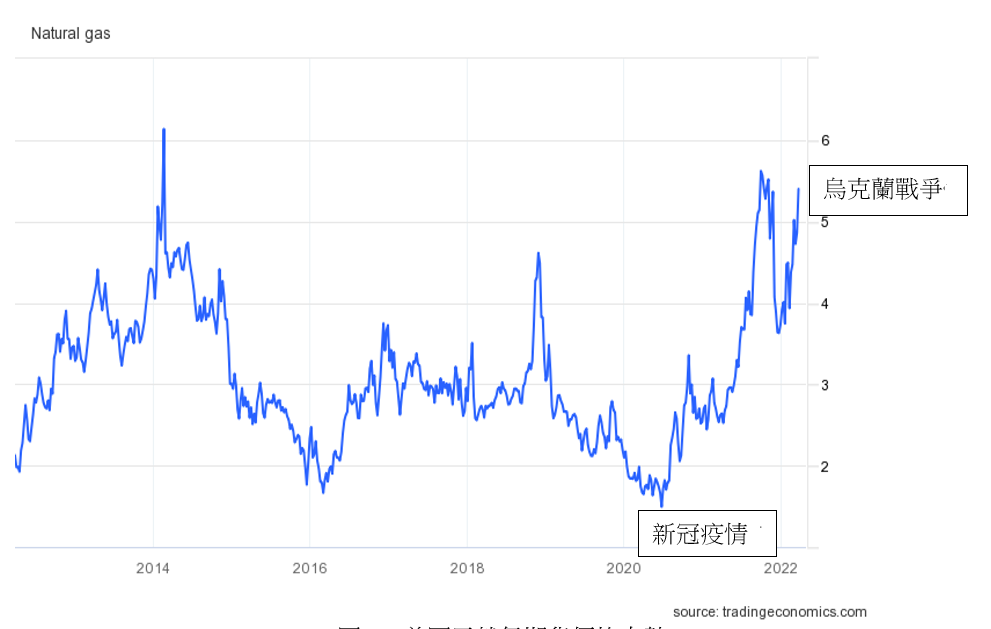
圖3:美國天然氣期貨價格走勢
環顧疫情期間的化石燃料和大宗商品價格走勢,化石燃料普遍下跌,主要是由於市場對未來經濟增長的憂慮,但太陽能光伏板需要的單晶或多晶硅,因全球供應鏈被擾亂及儲備不足而價格上漲。隨著世界各國逐步解除跨國旅遊及防疫措施的限制,疫後儲備不足的因素將逐漸消退,反觀全球經濟踏入通漲周期及地緣政治關係的緊張將再次成為了主導能源價格的重要因素。天然氣和煤價自2022年初烏克蘭戰爭再次出現大幅上升,歐洲社會要求擺脫依賴俄羅斯天然氣的呼聲日益高漲[11]。此外,地緣政治關係的緊張,即使是在疫情前或疫情期間,也正在使世界各國認真面對過度依賴全球化供應鏈的風險,開始建立國內的金屬資源庫存,或拉攏同盟國家建立供應鏈聯盟[12]。全球供應鏈格局的改變,將會影響未來化石燃料和可再生能源的發展。
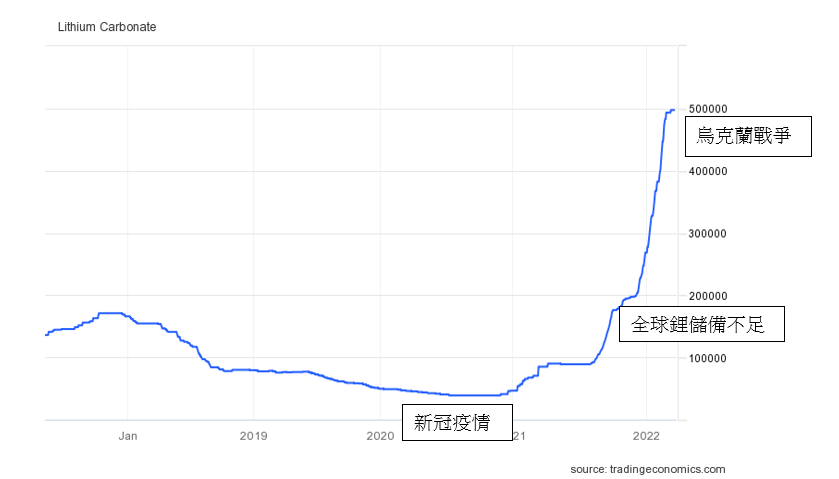
圖4:碳酸鋰期貨價格走勢
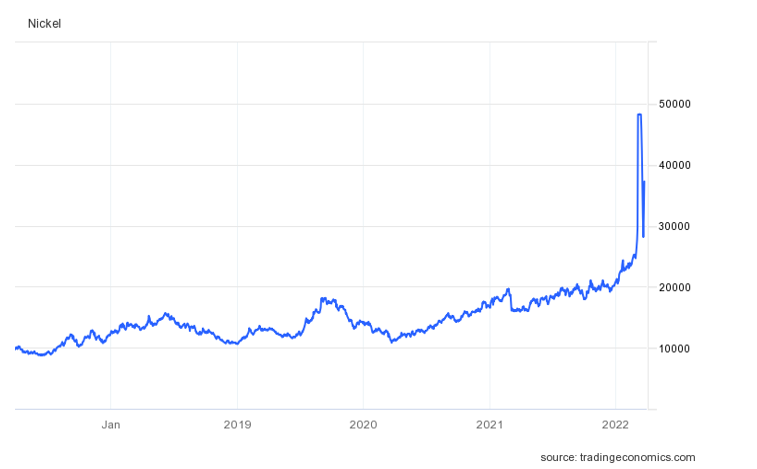
圖5:鎳金屬期貨價格走勢
至於全球供應鏈改變對香港可再生能源發展有何影響?在特區政府制定的《香港氣候行動藍圖》中提出2050年碳中和目標,以及2035年7.5-10%及2050年15%的可再生能源目標的大前提下,兩間電力公司(兩電)及其他能源供應商如何把握供應鏈格局改變的時機而達致目標,將會變得非常關鍵。內地擁有龐大的晶硅庫存及成熟的風電技術[13],相信香港要發展兩者應不會太受供應鏈改變的影響,只是需要注意市場價格及新冠疫情下物流供應及儲備緊張可能出現的波動。中電集團剛於2021年9月宣佈2050年淨零排放目標[14],值得鼓勵,而2021施政報告也要求兩電於2035年前停止所有燃煤發電。我們期待兩電和其他能源企業如何落實制定淘汰燃煤,以及改用可再生能源的路線圖和相關的投資計劃。
交通運輸行業的綠色復甦
其次,交通運輸也是香港碳排放的重要來源,佔18%[15]。新冠疫情一度使本地交通需求下降,同時也減少對汽油的需求。反觀近期的地緣政治關係緊張,甚至出現戰爭,進一步推高石油及成品油、天然氣價格,增加了長期依賴化石燃料國家的經濟和民生的風險。特區政府早前公佈《香港電動車普及化路線圖》,以及2021施政報告提及推動各種電動及其他新能源公共交通工具和商用車的發展,推廣使用零排放電動車和氫燃料汽車,及相關充電設備配套,取代化石燃料汽車,長遠減低交通運輸行業對化石燃料依賴的風險。
疫情期間,電動車電池需要的鋰及氫燃料電池所需要的鉑、鈀、鎳等金屬,總體價格偏低,主要是由於市場對未來經濟增長放緩,而對相關產品需求減少的憂慮。不過,亦正如化石燃料的價格趨勢一致,地緣政治關係緊張同樣大大影響相關金屬的價格,短期會影響電動車和氫燃料的發展, 而中長期則需要視乎各國建立自己的相關金屬庫存,及政府的復甦配套措施,包括對相關行業的技術開發支持,補貼或優惠措施,及思考如何抵禦疫情對物流的影響。
因此,我們在推進電動車和氫燃料汽車開發的同時,也需要考慮其他推動減少交通排放的方案,例如在交通規劃方面,設立更多行人專用區、在交通繁忙地區徵收車輛費用,都有助於降低使用汽車意慾,減少碳排放。
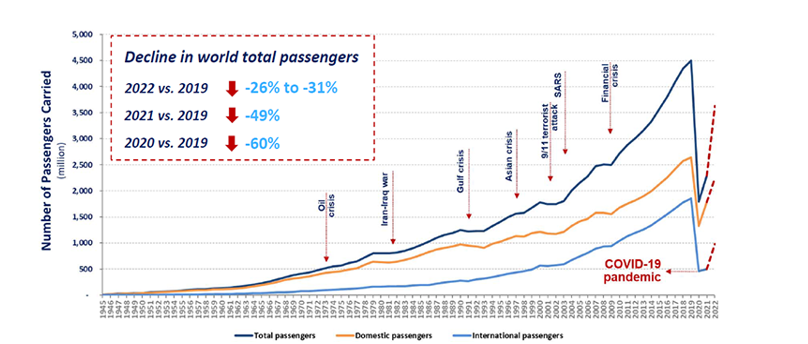
圖6:世界航空客運量演變走勢
來源:國際民航組織(ICAO)
至於跨境交通運輸方面,國際旅客在疫情期間大幅減少。許多國家關閉邊境或不容許特定國家的遊客入境,也有一些國家則對旅客入境採取檢疫措施或檢測要求。國際旅客流量的恢復比預期的要慢。2021年,雖然國際旅遊業增長了4%,與2020年相比,國際遊客(含過夜遊客)增加了1,500萬人次。然而,根據初步估計,國際入境人數仍比2019年疫情前低72%。2020年是有記錄以來旅遊業最差的一年,當年國際遊客減少了73%[16]。航空業亦正在面對史無前例的業務重整, 但同時,旅遊業和航空業界都預期,由於世界各國逐步放寬防疫限制,2022年國際航空運輸將會持續反彈,航空及相關旅遊業界的碳足跡和生態足跡也可能會呈現爆發式增長,正好是時機推動後疫情的綠色復甦。
後疫情的旅遊復甦,很大程度上視乎業界如何適應檢疫措施或檢測要求,而在旅客流量恢復緩慢的前提下,也是重新考慮平衡旅遊業發展與當地碳排放和生態系統帶來的影響。政府可以考慮利用這個機會推行累進的航空徵費,確保不常飛行的乘客每年可有一次航空旅行或參加海外家庭聚會,但又同時降低商務常客出行的意慾,從而鼓勵他們繼續進行網上會議。機場的擴建的需求也應該大幅放緩。旅遊業復甦可以優先考慮生態旅遊的潛力,強調保育香港的綠色休憩用地和生物多樣性,減少鋪張浪費的消費模式。2021施政報告也提及發展生態旅遊,但也要考慮「生態旅遊」是否能夠真正平衡生態保育和旅遊的需要,而不是在生態敏感地區大搞旅遊基建,無節制地吸引觀光旅客,產生大量碳足跡。
建築行業的綠色復甦
建築物佔每年香港電力消耗的九成,也佔碳排放的六成 ,所以建築物設計是否合乎能源效益對香港的碳排放舉足輕重,建築物淨零排放對香港也變得十分重要。從上文數據,商業和住宅用戶用電量在疫情放緩的2021年反彈至疫情前水平,住宅用戶更已有所超越。建築物的電力消耗增加不容忽視。特區政府制定《香港氣候行動藍圖》中的建築節能目標,是踏出減碳的重要一步,也有大量節能減碳的空間。
目前對於如何降低建築物能源消耗主要有兩個範疇。對於新建樓宇,提高建築物能源效益標準,結合低碳建築材料、低碳建設過程和有效的廢物處理的方案,促進智能建築設計,以及裝置可再生能源設施都是全球趨勢,而對於已建樓宇,可以先對建築物進行能源審計,針對性升級樓宇設施以幫助減少碳排放,也有助改善市民生活質素和身心健康。目前,香港機電工程署有制訂建築物能源效益守則及能源審核守則,而個別樓宇發展商和業主也可以參加專業組織設立的「綠建環評」計劃,對新建及已建樓宇的土地、水、能源消耗和廢物管理進行評級。但上述兩種途徑俱屬自願性質。一些亞洲城市,如首爾和東京 ,正在提供更多誘因鼓勵零能耗或綠色建築,甚至強制性裝置可再生能源,都是值得香港借鏡。
綠色復甦對金融、學術、創科和社區的意義
在綠色復甦的大趨勢下,香港金融業和科研人員迎接全新機遇,支援相關政策。除了特區政府目前已推出的綠色債券,及為支持粵港澳大灣區綠色金融而設立綠色和可持續金融中心,統籌業界持份者研究和制訂政策,更可以考慮特別針對氣候變化建立金融平台,統籌項目持有人、投資者、借貸方、優惠融資基金、技術和法律顧問,應對綠色投資項目的供應和需求,並催生公私營混合融資。此外,香港絕對有條件繼廣州碳排放權交易所,擔當更多碳排放交易的任務,先決條件是落實碳排放定價制度及相關交易系統。碳排放交易獲得的資金可以補貼本地交通和能源開支,減輕加價壓力,盈餘則可用於彌補各種的疫情補貼開支,以及應付疫情後上升的社會福利開支。2021施政報告支持香港發展成為綠色金融樞紐,我們希望特區政府的具體措施及方案帶動區內氣候變化緩減和適應措施的投融資。
此外,隨著全球環境、社會和治理(ESG)報告的大趨勢下,公私營公司,無論規模大小,都應該為碳審計和碳披露做好充分的準備,並制定實現碳中和的路線圖和承諾。要保持香港特別行政區作為中國和國際金融中心的競爭力,其中一個關鍵是對全球氣候危機做出迅速和進取的回應。美國和英國的領先企業已經承諾並採取措施實現碳中和,而內地也已成為應對碳排放的全球領先者之一,香港不可避免地在推進上市公司和私營公司在碳披露和碳中和方面發揮重要作用。
學術科研界特別是醫學界正在努力研究新冠疫情與氣候變化的關係,得出了以下主題 ,包括公共衛生在應對兩者的共同作用;全球長遠應對和適應兩者的方案;從社區和全球角度觀察兩者的相互關係;專業組織對兩者和環境影響的觀點和責任。然而,目前仍沒有文獻討論新冠疫情下受兩者影響弱勢社群的系統性和結構性問題,以及公共衛生和社區護理在應對兩者如何發揮著重要作用,開展相關科研長遠具有一定潛力。
創新科研人員除了需要研究香港這座城市如何更好適應氣候變化帶來的影響,對於全球最新的能源和能源效益技術,正好把握疫情後的機遇,加速發展並落實本地使用更形必需,包括氫燃料、電氣化渡輪、高效節能空調和地區冷卻系統、綠色金融科技,及智慧能源系統等。
新冠疫情和極端氣候為原有社區服務帶來新挑戰,但也有公義轉型的契機。弱勢社群面對的新冠疫情和極端氣候雙重威脅,原有社區支援服務提供者已難以適應。他們必須回到基本並重新學習,以提高他們預防和應對災難的能力。服務提供者也是處於最合適的位置去收集和提供數據,以便相關研究人員和政策制訂者進行深入的科學研究並制定更有效率的氣候適應政策。社會大眾對推動氣候變化減緩和適應是非常關鍵,公眾教育和公眾參與都是推動公義轉型的重要方法,如何讓公眾投入推動相關措施,政府能發揮有效的角色。
政府、商界和社區共同推動綠色復甦
最後,我們不應忘記特區政府在促進上述措施的重要角色,疫情後的綠色復甦也應該放在行政長官的議事日程。2021施政報告將大型基建計劃,包括北部都會區和明日大嶼列為優先發展項目,卻沒有提及和研究相關發展可能帶來的碳足跡,以及項目所潛在的氣候影響風險。有評論認為[18],北部都會區將會是洪水和颱風災害的潛在熱點地區,預測海平面上升2米將會每天帶來幾乎5-6米的沿海洪水,屆時通往深圳的兩條主要道路將被淹沒,似乎難以成為綠色復甦的措施。
2021施政報告亦提到行政長官正在主持氣候變化及碳中和督導委員會,而環境局將成立新的氣候變化與碳中和辦公室,並會成立專責的諮詢委員會,我們期望這三個部門和委員會能有效推動氣候減緩和適應措施的落實,尤其是評估災難風險、加強管治、投資於減低風險、而具有預防性的復甦措施。我們也希望2021施政報告所提出的經濟復甦措施是真正的綠色復甦,正如C40城市首長綠色和公義復甦議程的六大呼籲中最首要的原則:所有的經濟復甦措施都應該是綠色的,而且在推動C40城市首長綠色和公義復甦議程上,將綠色和公義轉型作用主導思想。特區政府也有責任協調跨部門與公營機構和私營企業共同推動碳披露和中和、以及支持公眾共同參與氣候變化減緩和應對氣候變化有關的災害,並落實到每一項政策裡。
延伸閱讀:
- 施日莊, 尋覓一線曙光:疫情後香港達成淨零排放的策略 ,香港:低碳想創坊 2021年9 月 。 https://www.ccinnolab.org/uploads/media/pairswatch/paris_watch_special_report_sustainable_recovery_CN_V3.pdf
- Ringsmuth, A.K. et al., “Lessons from COVID-19 for managing transboundary climate risks and building resilience,” Climate Risk Management, 35, 2022, 100395. Accessed on 28 March 2022. https://doi.org/10.1016/j.crm.2022.100395
- Selin, N.E., “Lessons from a pandemic for systems-oriented sustainability research,” Science Advances, 26 May 2021. Accessed on 28 March 2022. https://doi.org/10.1126/sciadv.abd8988
- Zang, S.M. et al., "The intersection of climate change with the era of COVID-19," Public Health Nursing, 2021, 00, 1-15. Accessed on 28 March 2022. https://doi.org/10.1111/phn.12866
參考資料:
- Ringsmuth, A.K. et al., “Lessons from COVID-19 for managing transboundary climate risks and building resilience,” Climate Risk Management, 35, 2022, 100395. Accessed on 28 March 2022. https://doi.org/10.1016/j.crm.2022.100395
- Selin, N.E., “Lessons from a pandemic for systems-oriented sustainability research,” Science Advances, 26 May 2021. Accessed on 28 March 2022. https://doi.org/10.1126/sciadv.abd8988
- Ruan, G., et al., “A cross-domain approach to analyzing the short-run impact of COVID-19 on the US electricity sector. Joule, 2020, 4, 2322–2337. Accessed on 28 March 2022.
- IEA, “CO2 emissions from energy combustion and industrial processes, 1900-2021,” 8 March 2022. Accessed on 28 March 2022. https://www.iea.org/data-and-statistics/charts/co2-emissions-from-energy-combustion-and-industrial-processes-1900-2021
- Reuters, “Pandemic recovery to push emissions to all-time high – IEA,” 20 July 2021. Accessed on 28 March 2022. https://www.reuters.com/business/environment/pandemic-recovery-push-emissions-all-time-high-iea-2021-07-20/
- IEA, “Global CO2 emissions rebounded to their highest level in history in 2021,” 8 March 2022. Accessed on 28 March 2022. https://www.iea.org/news/global-co2-emissions-rebounded-to-their-highest-level-in-history-in-2021
- 低碳想創坊,《尋覓一線曙光—疫情後香港達成淨零排放的策略》,2021年9月(2022年3月28日查閱 )。 https://www.ccinnolab.org/uploads/media/pairswatch/paris_watch_special_report_sustainable_recovery_CN_V3.pdf
- C40 Cities Climate Leadership Group, "C40 Mayors’ Agenda for a Green and Just Recovery," July 2020. Accessed on 28 March 2022. https://www.c40knowledgehub.org/s/article/C40-Mayors-Agenda-for-a-Green-and-Just-Recovery?language=en_US
- 香港特別行政區政府,《香港氣候行動藍圖2050 (第四章) 2021年10月(2022年3月28日查閱 )。 https://www.climateready.gov.hk/files/pdf/CAP2050_4_tc.pdf
- 中華電力有限公司及青山發電有限公司, 十年摘要:管制計劃業務的財務及營運統計 2022年3月28日查閱 )。 https://www.clpgroup.com/content/dam/clp-group/channels/investor/document/3-1/cSOC10yearsSummarychinese.pdf.coredownload.pdf ; 港燈電力投資有限公司, 2021年年報 2022年4月21日查閱)。 https://www.hkelectric.com/en/investor-relations/financial-reports/annual-report-2021
- The Economist, “Weaning Europe off Russian energy will mean making changes,” 26 March 2022. Accessed on 28 March 2022. https://www.economist.com/europe/2022/03/26/weaning-europe-off-russian-energy-will-mean-making-changes
- The Hill, “Biden administration announces mineral supply chain push.” 22 February 2022. Accessed on 28 March 2022. https://thehill.com/policy/energy-environment/595247-biden-administration-announces-mineral-supply-chain-push; Reuters, “Five Eyes alliance urged to forge ties with Greenland to secure minerals,” 4 March 2021. Accessed on 28 March 2022. https://www.reuters.com/business/energy/five-eyes-alliance-urged-forge-ties-with-greenland-secure-minerals-2021-03-04/
- S&P Global, “China's 2021 silicon exports seen up 23% on year, Q1 2022 demand to rise: agency,” 29 November 2021. Accessed on 28 March 2022. https://www.spglobal.com/commodity-insights/en/market-insights/latest-news/metals/112921-chinas-2021-silicon-exports-seen-up-23-on-year-q1-2022-demand-to-rise-agency; Global Times, “China’s installed wind power capacity exceeds 300 mln kW, 1.4 times EU levels and 2.6 times that of US,” 29 November 2021. Accessed on 28 March 2022. https://www.globaltimes.cn/page/202111/1240202.shtml
- CLP Group, “Decarbonisation,” Accessed on 28 March 2022. https://www.clpgroup.com/zh_hk/sustainability/strategic-priorities/decarbonisation.html
- 香港特別行政區政府,《香港氣候行動藍圖2050 (第四章) 2021年10月(2022年3月28日查閱 )。 https://www.climateready.gov.hk/files/pdf/CAP2050_4_tc.pdf
- World Trade Organisation, “UNWTO World Tourism Barometer Data,” Accessed on 28 March 2022. https://www.unwto.org/unwto-world-tourism- barometer-data
- Zang, S.M. et al., "The intersection of climate change with the era of COVID-19," Public Health Nursing, 2021, 00, 1-15. Accessed on 28 March 2022. https://doi.org/10.1111/phn.12866
- Low, C.T., “IPCC AR6 WG2 Demands We Build a Climate Resilient Northern Metropolis,” China Water Risk, 23 March 2022. Accessed on 28 March 2022. https://www.chinawaterrisk.org/resources/analysis-reviews/ipcc-ar6-wg2-demands-we-build-a-climate-resilient-northern-metropolis/
作者︰
低碳想創坊研究員李育成先生

The Study of Coastal Hazards under Climate Change and Extreme Weather and Formulation of Improvement Measures - Feasibility Study (Coastal Hazards Study) has comprehensively reviewed the impacts of storm surges and waves on coastal low-lying or windy locations under extreme weather and climate change.
It has identified 26 coastal low-lying or windy residential areas with higher risks (details see diagram below) for formulation of improvement works and management measures to safeguard public safety.
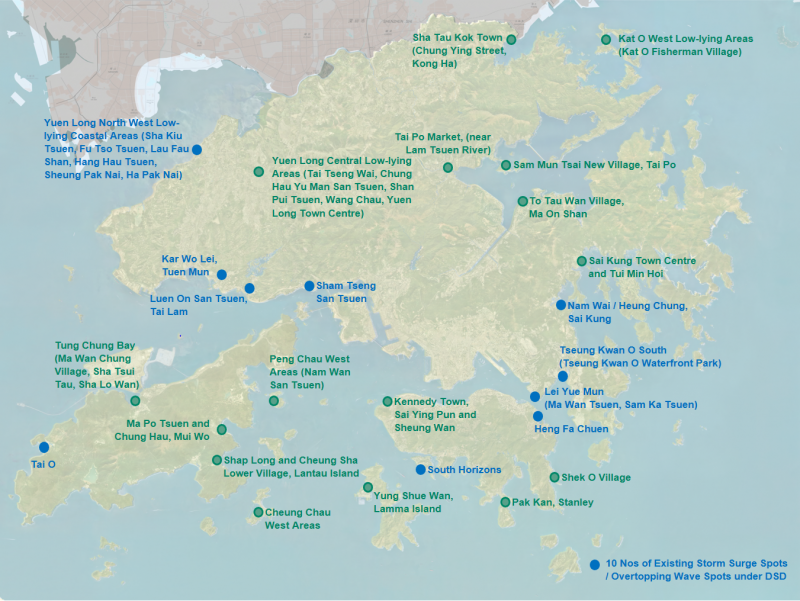
The improvement works comprise various protective and adaptive options, which may include constructing or raising wave walls along the coastline, installing flood barriers at suitable places behind the coastline to cut off water pathways towards inland areas, and/or installing demountable flood barriers at building frontages. Management measures will involve the formulation of action plans on early alert systems and emergency preparedness. The final report and executive summary of the Coastal Hazards Study are as below.
*This article originates from Civil Engineering and Development Department (CEDD).
https://www.cedd.gov.hk/eng/our-projects/project-reports/index-id-24.html

The Hong Kong Jockey Club Disaster Preparedness and Response Institute (“HKJCDPRI”) has commissioned the Centre for Communication and Public Opinion Survey (“CCPOS”) at The Chinese University of Hong Kong (“CUHK”) to conduct an opinion survey about Hong Kong people’s views towards the provision of help to people with mental distress (“the Survey”). Specfically, the Survey aimed to examine the following issues:
- Opinions on providing help to people with mental distress
- Mental distress situation of acquaintance
- Situations of providing help to acquaintance with mental distress
- Opinions on learning how to acquaintance with mental distress
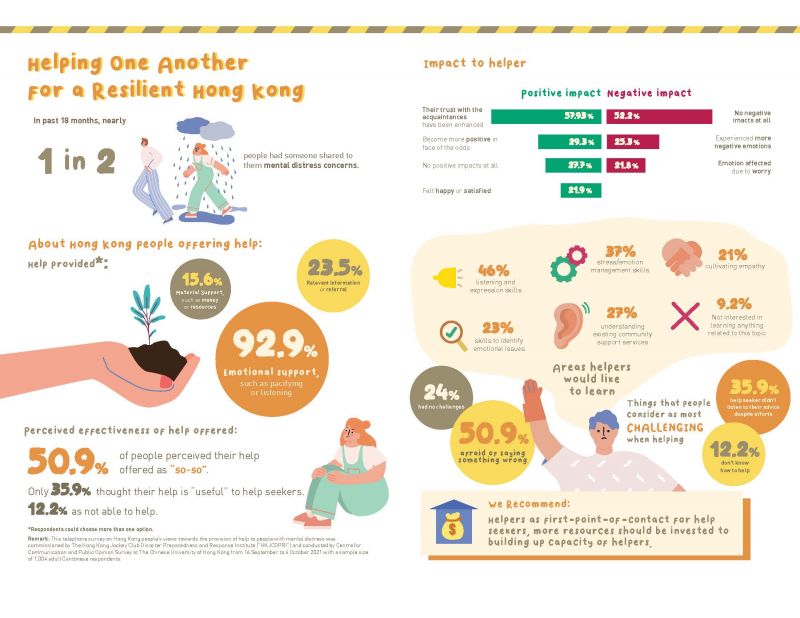
A telephone survey was conducted from 16 September to 4 October 2021 with Hong Kong residents aged 18 or above (Cantonese speakers), which produced a sample size of 1,004 respondents. The main findings of the Survey are summarized as follows:
Opinions on providing help to people with mental distress
- The respondents were asked whether they would be willing to provide help when other people mentioned their mental distress (such as unhappiness, worry, anexiety or anger, etc.) to them. Over seven in ten repsondents (71.9%)said they were willing to help; more than one-fifth (22.5%) said “so-so”; and only a tiny portion (3.2%) said not willing.
- If there were a need for the respondents to help the people with mental distress, over half of them (56.7%) said their confidence level of provding useful help to the people in need was just “so-so”. The proportion of respondents lacking confidence (23.5%) was higher than that of respondents having the confidence (18.3%).
- The respondents thought that the main difficulties of helping the people with mental distress were “don’t know how to help them” (44.3%), “don’t know how to pacify them” (32.0%), “no time” (20.1%) and “don’t understand their troubles” (19.9%)。
Mental distress situation of acquaintance
- Nearly half of the respondents (47.9%) have had their acquaintances (including family members, friends, colleagues, classmates, neighbours or people they met in work) mentioning to them about their mental distress (such as unhappiness, worry, anexiety or anger, etc.) in the past 18 months. And over half of the respondents (52.1%) said they have not encountered this situation.
- Those acquaintances were mainly the “friends” (65.3%), “family members” (31.2%) and “colleages” (20.4%) of the respondents.
- The main sources of mental distress of those acquaintances were about “family” (37.0%) and “work” (36.7%) and as well as “social events” (30.0%) and “the pandemic” (29.2%).
- According to the respondents, those acquaintances mainly had the following symptoms of mental distress: “easy to feel depressed, worried or panicky” (47.9%), “easy to feel anxious, angry or frustrated” (43.6%) and “always suffer from insomnia ” (43.3%).
- Over half of the respondents (51.5%) said that, there was no difference in the number of people mentioning to them about their mental distress between now and before the pandemic. However, more than two-fifths of the respondents (45.7%) said the number of help-seekers has increased; whereas a tiny portion of the respondents (2.4%) said there were fewer help-seekers now.
Situations of providing help to acquaintance with mental distress
- For those respondents who have had their acquaintances mentioning to them about their mental distress in the past 18 months, the overwhelming majority of them (98.1%) have tried/ sometimes have tried to provide some forms of help to the help-seekers, such as listening to their concerns or providing them information or advices. Only a tiny portion of the respondents (1.9%) have not tried to provide any help at all.
- The help being provided by the respondents was mainly “emotional support, such as pacifying or listening”(92.9%). It was then followed by “provding information or referral” (23.5%) and “material support, such as money or resources, etc.” (15.6%).
- In the helping process, the main difficulties encountered by the respondents were “afraid of saying wrong things” (34.4%), “the help-seekers were not listening even I have already spoken a lot” (34.2%) and “don’t know how to help” (31.0%).
- The respondents were asked to evaluate whether their provided help could be able to help the help-seekers. Around half of the respondents (50.9%) said the outcome was only “so-so”. Over three in ten respondents (35.9%) believed that their help was useful for the help-seekers; however, over one in ten respondents (12.2%) believed that their provided help was not able to help the help-seekers.
- Nearly three-fifths of the respondents expressed that having provided help to the acquaintances with mental distress, “their trust with the acquaintances have been enhanced” (57.3%). Nearly three in ten respondents said that they “have become more positive in face of the odds” (29.3%). Moreover, about one-fifth of the respondents “have felt happy or satisfied” (21.9%). However, there was also more than a quarter of the respondents (27.7%) experiencing “no positive impacts at all” in helping others.
- As far as negative impacts are concerned, over half of the respondents (52.2%) said that providing help to the acquaintances with mental distress has caused “no negative impacts” on them. However, over one-fifth of the respondents have said “they have experienced more negative emotions” (25.3%) and “their emotion has been affected because of worry” (21.8%) respectively.
- As mentioned above (point 9), some respondents have not tried/ sometimes have not tried to provide help to the acquaintances with mental distress. Their main reasons were “don’t know how to help” (47.9%), “the relationship with them wasn’t that close” (18.3%), “they may not want me to help them” (11.9%), “just trivial matters; no need to help” (10.7%) and “afraid of being troubled” (7.9%).
Opinions on learning how to acquaintance with mental distress
- Finally, the Survey asked all respondents what knowledge or skills they would like to learn for helping people with mental distress. The top choice was “listening and presentation skills” (46.2%), which was followed by “the methods of reducing stress or releasing emotions (36.6%), understanding“existing supportive services in the community” (26.8 %), “identifying emotional health problems” (22.7%) and “cultivating empathy” (20.6%). However, close to one in ten repsondents (9.2%) have expressed no interest in all above-mentioned items.



